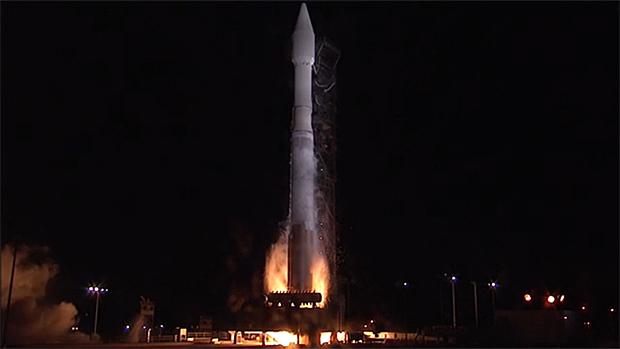Atlas 5 rocket takes off carrying secret military payload
A United Launch Alliance Atlas 5 rocket blasted off from the coast of California early Thursday, boosting a classified National Reconnaissance Office payload into orbit.
The rocket also carried 13 small "CubeSat" satellites into space for NASA, the NRO, university researchers and private industry, part of an on-going initiative to develop low-cost, high-tech sensors and other technologies with applications across a variety of disciplines.
The NROL-55 mission got underway with a spectacular blast off from Space Launch Complex 3 at Vandenberg Air Force Base at 8:49 a.m. EDT (GMT-4; 5:49 a.m. local time).
In one of the on-going ironies of the U.S. military space program, the 188-foot-tall rocket and its classified payload climbed away on the power of a Russian-built RD-180 first-stage engine generating some 860,000 pounds of thrust while gulping more than 1,000 pounds of propellant per second.
Putting on a spectacular pre-dawn show, the Atlas 5 quickly arced away to the south over the Pacific Ocean, beaming back dramatic "rocketcam" views of the launch site falling away below.
About four minutes after liftoff, the RD-180 shut down, the first stage fell away and the ascent continued on the power of the Centaur second stage's Aerojet Rocketdyne RL10 engine. As usual with missions involving classified payloads, ULA ended its launch commentary shortly after stage separation and provided no details about the rocket's payload, ascent performance or intended orbit.
It was the 101st launch of a ULA rocket since Boeing, builder of Delta rockets, and Lockheed Martin, builder of the Atlas, joined forces to provide evolved expendable launch vehicles, or EELVs, to the Air Force. The flight came just six days after ULA launched an Atlas 5 from Florida carrying a Mexican communications satellite.
While the identity of the payload launched Thursday was not announced, amateur satellite trackers speculated it was made up of two Naval Ocean Surveillance Satellites, the latest members of a constellation of spacecraft designed to track ships at sea by analyzing radio transmissions.
The current generation of NOSS satellites are believed to operate in a 700-mile-high orbit tilted 63 degrees to the equator.
Ted Molczan, a noted satellite analyst, told Spaceflight Now that the first two generations of NOSS satellites, launched between 1976 and 1996, used three spacecraft, flying in close formation, to pin down a ship's location. The NOSS system now requires just two spacecraft to accomplish the same objective.
Along with the presumed NOSS satellites, the Atlas 5 also carried 13 CubeSats mounted in a common deployment mechanism near the base of the rocket's second stage known as the Government Rideshare Advanced Concepts Experiment, or GRACE.
Nine of the diminutive spacecraft were sponsored by the NRO and four were sponsored by NASA. CubeSats are miniature, cube-shaped satellites measuring 4 inches on a side and weighing less than 3 pounds. Two or more can be connected to form larger, more complex spacecraft.
"NASA's CubeSat launch initiative enables the launch of CubeSat projects designed, built and operated by students, teachers, faculty and government researchers," said Steven Jurczyk, associate administrator of NASA's space technology mission directorate.
"We believe our investments will advance the capabilities of small spacecraft to support NASA missions in exploration, operations and our four science disciplines -- planetary science, Earth science, heliophysics and astrophysics," he said. "Our ultimate goal is to promote small spacecraft as a paradigm shift for NASA and the larger space community."
The NRO CubeSats included two, known as AeroCube-5C and AeroCube-7, that were designed to test tracking technology and optical communications using compact lasers. Three CubeSats, known as SNaP-3, were designed to test software-defined radios "for disadvantaged users in remote locations," the NRO said in a web posting.
Two more NRO CubeSats, known collectively as PropCube, were built to perform "dual-frequency ionospheric calibration measurements" while two more, known as SINOD-D, were built for another demonstration of software-defined radio technology.
"The NRO recognizes the utility of CubeSats as a cost-effective way of exploring new technology and concepts of operation," said Meagan Hubbell, deputy chief of the NRO's CubeSat program office. "CubeSats are a great way to inspire innovation and cool science."
The four NASA CubeSats included one, known as BisonSat, that was developed by students at the Salish Kootenai College in Montana to study land and cloud cover and to give native Americans hands-on experience building space hardware.
The University of Alaska provided ARC-1 to test a high-bandwidth communications system and to measure the temperatures and vibrations experienced by CubeSats during launch.
"We use cheap, off-the-shelf parts," said Morgan Johnson, a graduate student at the University of Alaska-Fairbanks. "For our antenna, you can see we have (an extended) tape measure, it works for UHF connections. For the launch environment data logger, we're just using triple-A batteries. We are using a webcam for our camera, and we're also using the radios we learned to use in our wireless sensor network class, we're using those radios to make our satellite work.
"So it's just really interesting to take this project from what we're learning in school to producing a satellite that we're going to launch and have in space," she said.
The Radio Amateur Satellite Corp., or AMSAT, provided the FOX-1 CubeSat designed to enable amateurs around the world to communicate via satellite. A Penn State experiment will test equipment designed to measure the spin of CubeSats and a Vanderbilt University experiment will look at how space radiation affects off-the-shelf computer chips.
The Low-Mass Radio Science Transponder CubeSat, provided by NASA's Jet Propulsion Laboratory, will test low-cost, lightweight hardware useful in radio science experiments to study planetary atmospheres and other phenomena.
This was the 58th launch of an Atlas 5 since the rocket's maiden flight in 2002, the booster's 12th launch for the NRO and the ninth of 11 flights planned this year by ULA.


